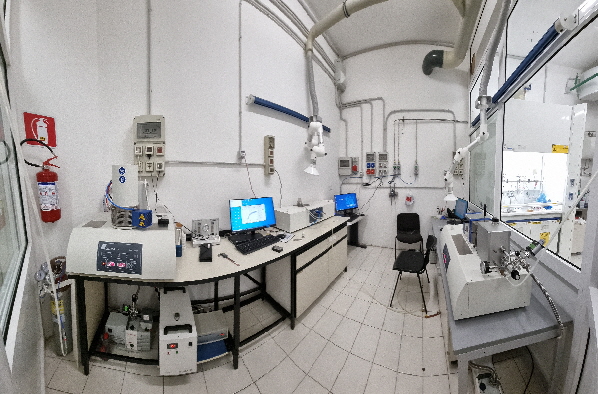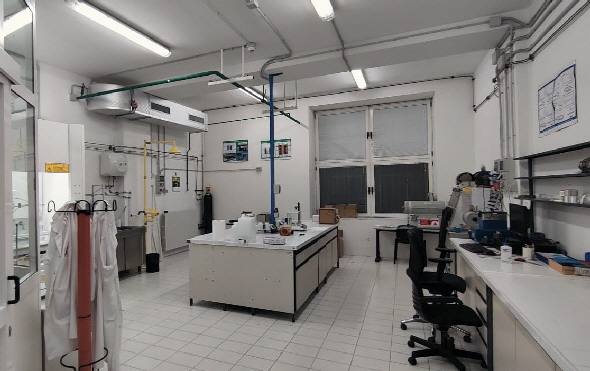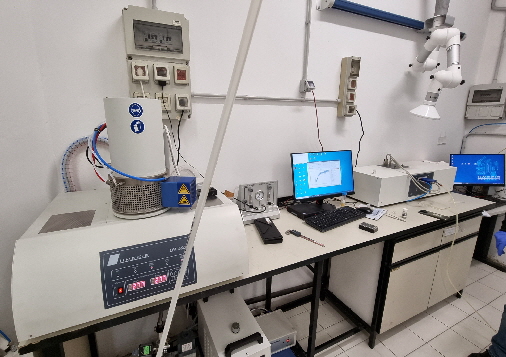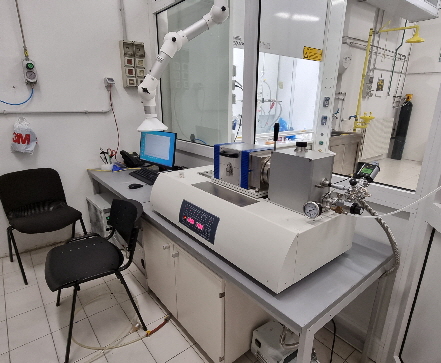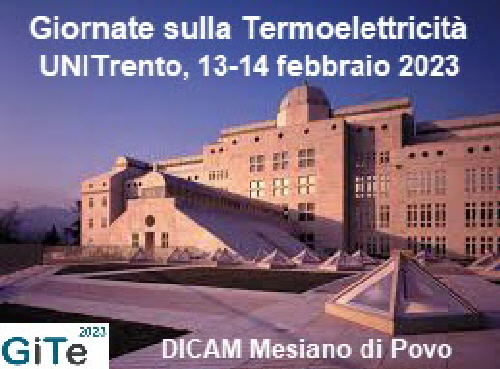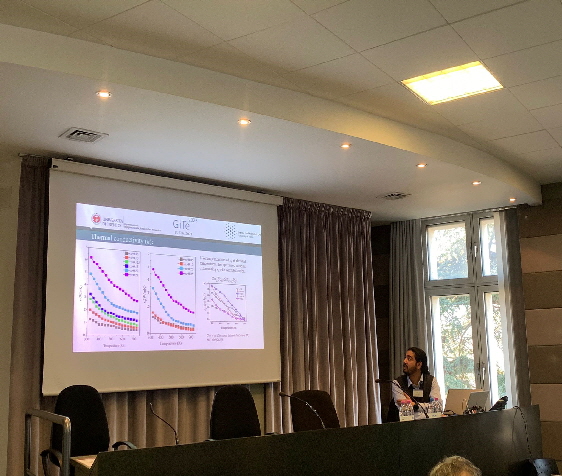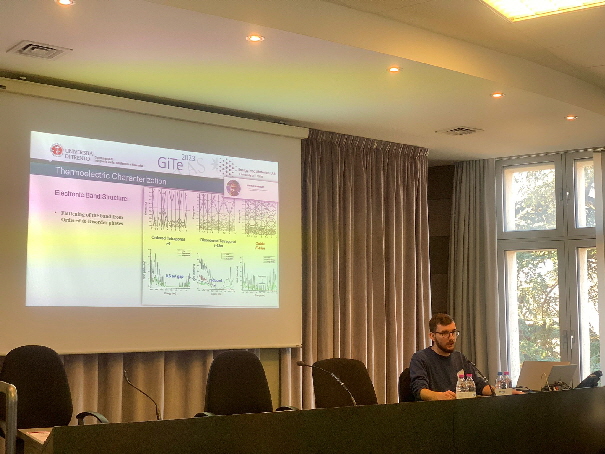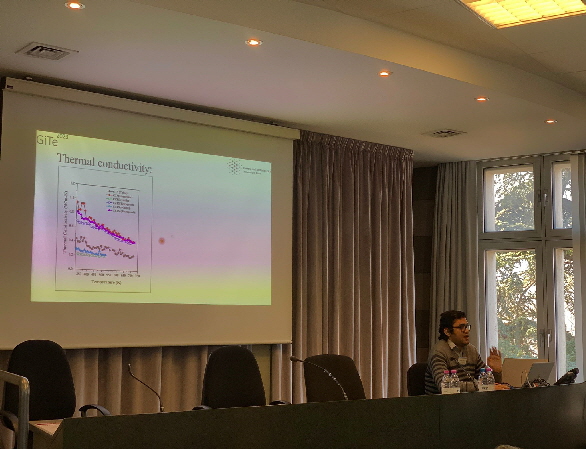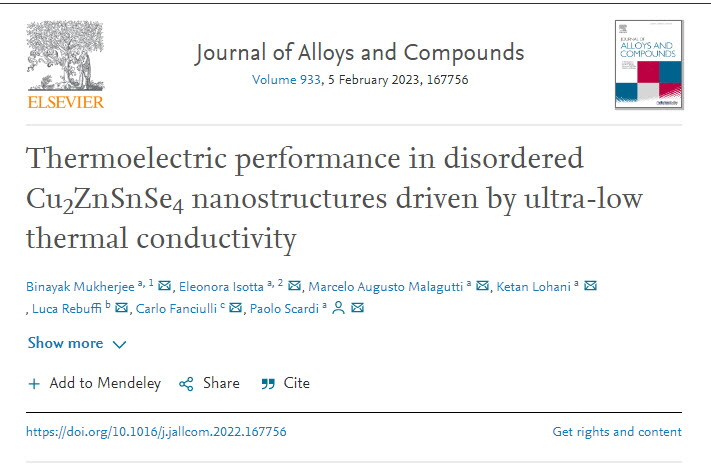NEWS: 2023 from the team
August 30, 2023
Anion Exchange Membranes Based on Chemical Modification of Recycled PET Bottles
Varun Donnakatte Neelalochana, Eleonora Tomasino, Rosa Di Maggio, Oscar Cotini, Paolo Scardi, Stefano Mammi, and Narges Ataollahi
ACS Appl. Polym. Mater. 2023
https://doi.org/10.1021/acsapm.3c01391
Abstract
This study presents an innovative and effective solution for recycling PET bottles as raw for producing anion exchange membranes (AEMs) for electrochemical applications. This approach reduces the demand for pristine materials, a key principle of the circular economy and sustainability. PET was subjected to chemical modification by introducing cationic functional groups followed by methylation and OH– exchange process. The amination synthesis was optimized based on reaction time. The results indicate that ion exchange capacity, water uptake, and swelling ratio properties mainly depend on the degree of cationic functionalization. The optimized AEM exhibits ionic conductivity of 5.3 × 10–2 S·cm–1 and alkaline stability of 432 h in 1 M KOH at 80 °C. The membrane properties before and after the alkaline treatment were investigated using Fourier-transform infrared spectroscopy, thermogravimetric analysis, and scanning electron microscopy analysis. Computational chemistry analysis was employed to gain further insights into the membrane degradation mechanisms and pathways under alkaline conditions. This research and its findings are a step toward using recycled materials in the field of AEM technology.
Keywords: PET bottle, anion exchange membrane, chemical modification, electrochemical application, cationic functional group, amination, syntheses, alkaline stability, oxidation stability, sustainability

May 25, 2023
Himanshu Nautiyal PhD Thesis Dissertation
Title: Electronic structure calculations of Thermoelectric Materials
In his Ph.D. thesis, Himanshu Nautiyal used first-principle electronic structure calculations to investigate potential sustainable thermoelectric materials. The focus of the research was the thorough examination of promising materials, particularly copper-based ternary and quaternary compounds and monolayers of SnS2, SnSe2, and Janus SnSSe. Clarifying the impact of structural disorder on the transport properties of these materials was a vital component of the investigation. Various approaches, such as Density Functional Theory (DFT), Ab-initio Molecular Dynamics (AIMD), and Boltzmann transport theory, were used to achieve a thorough understanding. This allowed for an in-depth investigation of electronic and phonon transport features. The results offer fascinating opportunities for the development of high-performance thermoelectric materials and devices.
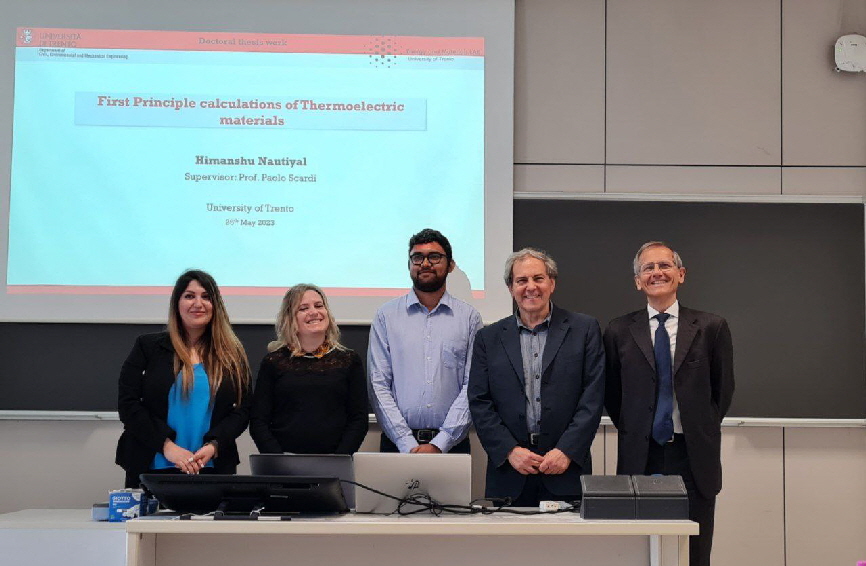
May 10, 2023
Enhanced Thermoelectric Performance of Nanostructured Cu2SnS3 (CTS) via Ag Doping
Ketan Lohani, Himanshu Nautiyal, Narges Ataollahi, Umberto Anselmi-Tamburini Umberto Anselmi-Tamburini, Carlo Fanciulli, and Paolo Scardi
ACS Appl. Nano Mater. 2023, 6, 7, 6323–6333
https://doi.org/10.1021/acsanm.3c00716
Abstract
The present work aims to investigate the effect of Ag doping on the thermoelectric properties of Cu2SnS3 (CTS). Various Cu2Ag(x)Sn(1–x)S3 (0.05 ≤ x ≤ 0.25) samples were synthesized by mechanical alloying followed by spark plasma sintering, and their structural and transport properties were systematically investigated. The x = 0.15 sample presented a ∼10-fold higher power factor than the undoped CTS. Although, the x = 0.125 sample had a lower power factor than the x = 0.15 sample, owing to its lower thermal conductivity, both the samples showed the highest zT ∼ 0.8 at 723 K. This value is comparable to the best results available in the literature for earth-abundant and eco-friendly thermoelectric materials. Interestingly, the thermal conductivity of Cu2Ag(x)Sn(1–x)S3 samples increased with Ag substitution, which was further investigated using the first-principles and ab initio molecular dynamics calculations. It was observed that the incorporation of Ag into the system decreases the root mean square displacement of the other cations and anions, reducing the scattering of phonons and thereby increasing the lattice thermal conductivity. Moreover, the calculations on the formation energy have revealed the reason for the structural transformation of CTS and similar diamond-like structures toward high symmetry polymorphs by external doping. The increase in zT is directly related to the optimization of the band gap and the weighted mobility, which have been investigated experimentally and using the first principle method.
Keywords: :Cu2SnS3 copper tin sulfide CTS thermoelectricity chalcogenides mechanical alloying spark plasma sintering lattice thermal conductivity weighted mobility DFT AIMD
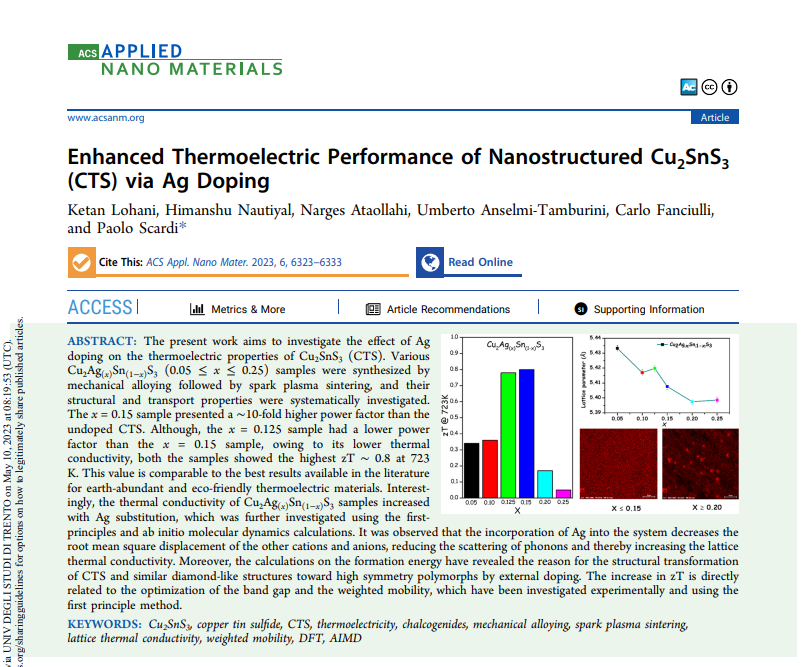
X-ray powder diffraction in education. Part II. Intensity of a powder pattern
Robert Dinnebier and Paolo Scardi
Journal of applied crystallography
Volume 56, 9 May 2023
https://doi.org/10.1107/S1600576723002121
Abstract
This article is the second part of a series dealing with the description and visualization of mathematical functions used to describe a powder diffraction pattern for teaching and education purposes. The first part dealt with the instrumental and sample contributions to the profile of a Bragg peak [Dinnebier & Scardi (2021). J. Appl. Cryst. 54, 1811–1831]. The second part, here, deals with the mathematics and physics of the intensity in X-ray powder diffraction. Scholarly scripts are again provided using the Wolfram language in Mathematica.
Keywords: powder diffraction; peak intensity; intensity corrections; powder patterns; Mathematica.

Roadmap on thermoelectricity
Cristina Artini, Giovanni Pennelli, Patrizio Graziosi, Zhen Li, Neophytos Neophytou, Claudio Melis, Luciano Colombo, Eleonora Isotta, Ketan Lohani, Paolo Scardi, Alberto Castellero, Marcello Baricco, Mauro Palumbo, Silvia Casassa, Lorenzo Maschio, Marcella Pani, Giovanna Latronico, Paolo Mele, Francesca Di Benedetto, Gaetano Contento, Maria Federica De Riccardis, Raffaele Fucci, Barbara Palazzo, Antonella Rizzo, Valeria Demontis, Domenic Prete, Muhammad Isram, Francesco Rossella, Alberto Ferrario, Alvise Miozzo, Stefano Boldrini, Elisabetta Dimaggio, Marcello Franzini, Simone Galliano, Claudia Barolo, Saeed Mardi, Andrea Reale, Bruno Lorenzi, Dario Narducci, Vanira Trifiletti, Silvia Milita, Alessandro Bellucci and Daniele M Trucchi
Nanotechnology, Volume 34, 9 May 2023, 292001
https://doi.org/10.1088/1361-6528/acca88
Abstract
The increasing energy demand and the ever more pressing need for clean technologies of energy conversion pose one of the most urgent and complicated issues of our age. Thermoelectricity, namely the direct conversion of waste heat into electricity, is a promising technique based on a long-standing physical phenomenon, which still has not fully developed its potential, mainly due to the low efficiency of the process. In order to improve the thermoelectric performance, a huge effort is being made by physicists, materials scientists and engineers, with the primary aims of better understanding the fundamental issues ruling the improvement of the thermoelectric figure of merit, and finally building the most efficient thermoelectric devices. In this Roadmap an overview is given about the most recent experimental and computational results obtained within the Italian research community on the optimization of composition and morphology of some thermoelectric materials, as well as on the design of thermoelectric and hybrid thermoelectric/photovoltaic devices.
Keywords: thermoelectricity, thermoelectric materials, thermoelectric devices, heat transport, electronic transport, modelling
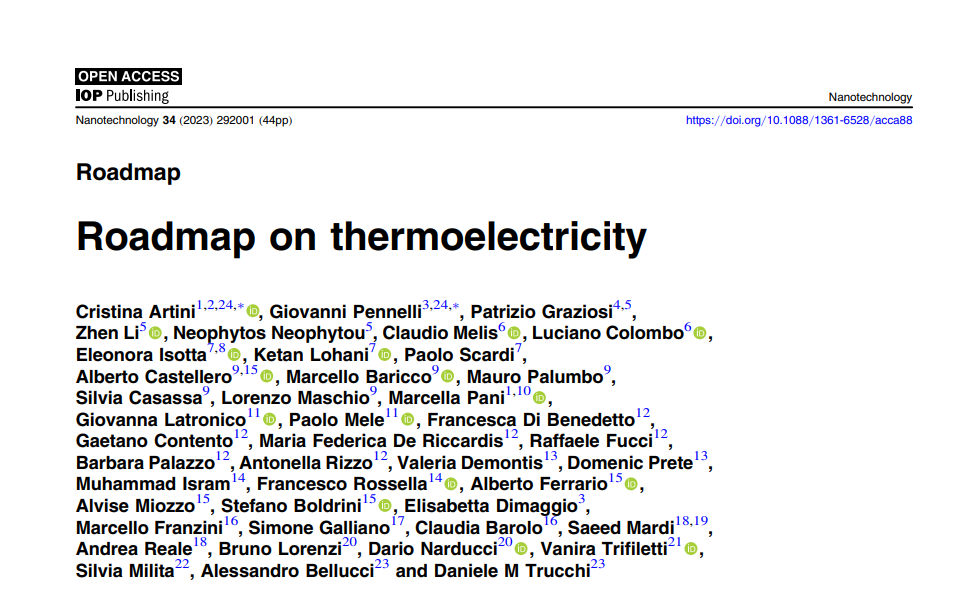
March, 2023
New laboratory for full thermoelectric characterization is now operating in our university.
Setup:
1. Linseis LSR-3 Seebeck: Electrical resitivity and Seebeck coefficient for bulk and thin films analysis
2. Linseis LFA 500: Thermal conductivity/diffusivity and specific heat for bulk disk shaped samples
New instrument:
3. Hall-Effect Characterization System 1: for precise measure of electrical resistivity, Seebeck coefficient (thermos power), carrier concentration, and carrier mobility using the Van-der-Paul configuration.
Specification: Resistivity range of 10-4 to 107 Ω cm, carrier concentration of 107 up to 1021 cm-3, and mobility range of 10-2 to 107 cm2/(V s).
Additional features: It operates in a vacuum and inert atmosphere. Measurements from room to 200° C. Easy to mount the samples and operate.
New Electrochemical Energy Laboratory: Synthesis of polymeric material and nanoparticles for electrochemical applications
February 13-14, 2023
Link sito web GiTe2023: https://gite.icmate.cnr.it/
DAYS ON THE THERMOELECTRICITY 2023 / GIORNATA DELLA TERMOELETTRICITÀ 2023 (GiTe 2023) by the Italian Thermoelectric Association (AIT) was successfully organized (13-14 February) at Department of Civil, Environmental & Mechanical Engineering (DICAM) University of Trento.
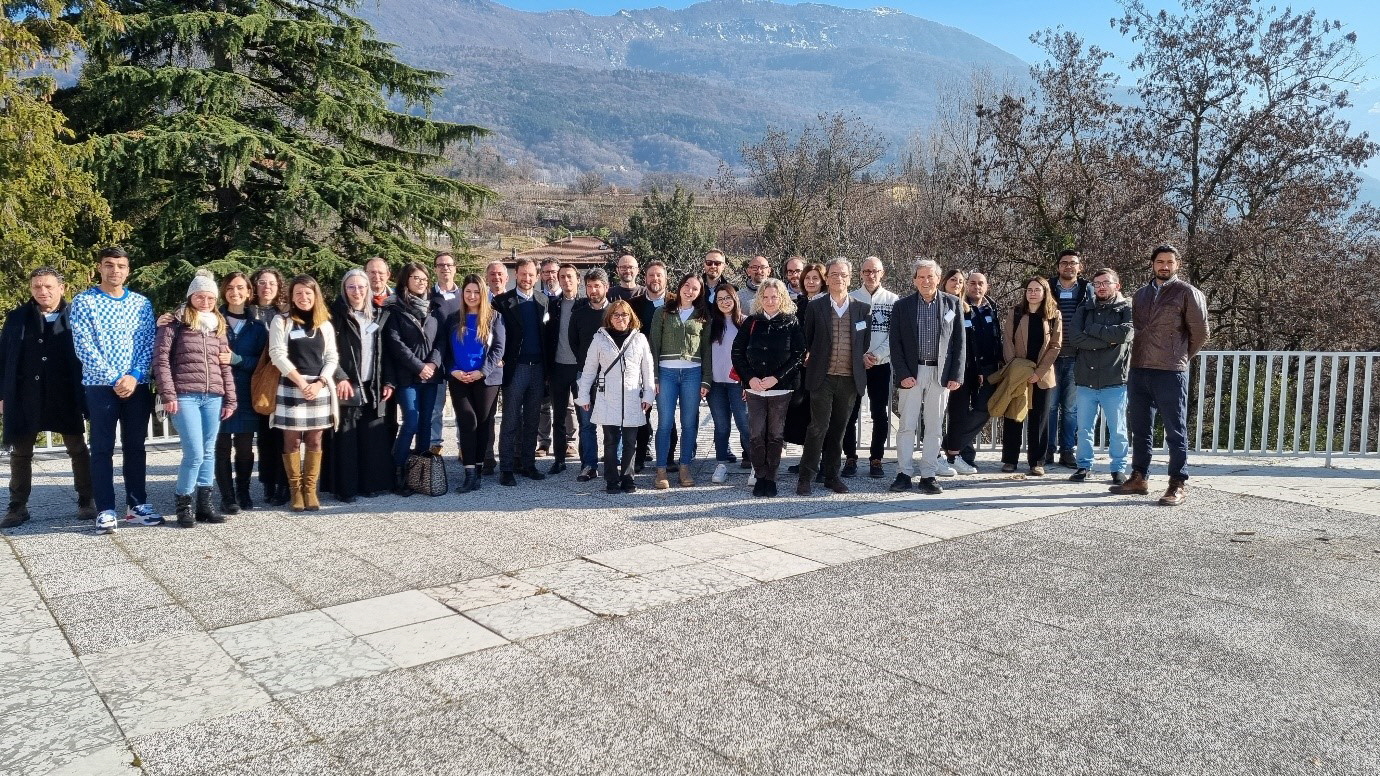
Ketan Lohani presented “Optimization of Thermoelectric Properties of Cu2SnS3 (CTS) via Ag Substitution at the Sn Site”. During Gite 2023, the Italian Thermoelectric Association awarded the prize for the best junior talk to Ketan Lohani, of the University of Trento, for the communication "Optimization of Thermoelectric Properties of Cu2SnS3 (CTS) via Ag Substitution at the Sn Site" .
Marcelo Augusto Malagutti presented “Thermoelectric Performance in Disordered Cu2ZnSnSe4 Nanostructures Driven by Ultra-Low Thermal Conductivity”.
Himanshu Nautiyal presented “Sustainable Ternary and Quaternary Nanostructured Cu2SnS3, Cu2ZnSnS4 and Cu2ZnSnSe4 Chalcogenides for Thermoelectric Applications”..
January 16, 2023
Mechanochemical Synthesis of Sustainable Ternary and Quaternary Nanostructured Cu2SnS3, Cu2ZnSnS4, and Cu2ZnSnSe4 Chalcogenides for Thermoelectric Applications
Himanshu Nautiyal, Ketan Lohani, Binayak Mukherjee, Eleonora Isotta, Marcelo AugustoMalagutti, Narges Ataollahi, Ilaria Pallecchi, Marina Putti, Scott T. Misture, Luca Rebuffi and Paolo Scardi
https://doi.org/10.3390/nano13020366
Abstract
Copper-based chalcogenides have emerged as promising thermoelectric materials due to their high thermoelectric performance, tunable transport properties, earth abundance and low toxicity. We have presented an overview of experimental results and first-principal calculations investigating the thermoelectric properties of various polymorphs of Cu2SnS3 (CTS), Cu2ZnSnS4 (CZTS), and Cu2ZnSnSe4 (CZTSe) synthesized by high-energy reactive mechanical alloying (ball milling). Of particular interest are the disordered polymorphs of these materials, which exhibit phonon-glass–electron-crystal behavior—a decoupling of electron and phonon transport properties. The interplay of cationic disorder and nanostructuring leads to ultra-low thermal conductivities while enhancing electronic transport. These beneficial transport properties are the consequence of a plethora of features, including trap states, anharmonicity, rattling, and conductive surface states, both topologically trivial and non-trivial. Based on experimental results and computational methods, this report aims to elucidate the details of the electronic and lattice transport properties, thereby confirming that the higher thermoelectric (TE) performance of disordered polymorphs is essentially due to their complex crystallographic structures. In addition, we have presented synchrotron X-ray diffraction (SR-XRD) measurements and ab initio molecular dynamics (AIMD) simulations of the root-mean-square displacement (RMSD) in these materials, confirming anharmonicity and bond inhomogeneity for disordered polymorphs.
Keywords: Cu-based ternaries and quaternaries; thermoelectricity; Cu2ZnSnS4; Cu2ZnSnSe4; Cu2SnS3; mechanochemistry; order–disorder; X-ray diffraction; density function theory; ab-initio molecular dynamics; Raman spectroscopy
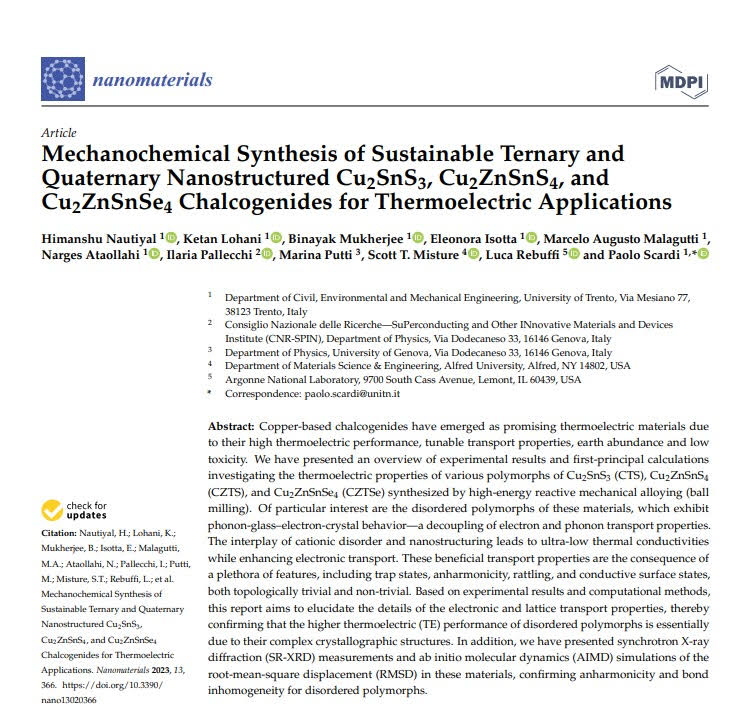
February 5, 2023
Thermoelectric performance in disordered Cu2ZnSnSe4 nanostructures driven by ultra-low thermal conductivity
Binayak Mukherjee, Eleonora Isotta, Marcelo Augusto Malagutti, Ketan Lohani, Luca Rebuffi, Carlo Fanciulli, Paolo Scardi
Abstract
High-energy reactive mechanical alloying (ball milling) was used to synthesize tetragonal and cubic polymorphs of Cu2ZnSnSe4. The ordered tetragonal (I-4) polymorph undergoes a phase transition above 400 K into a Cu-Zn disordered tetragonal (I-42 m) polymorph, while the cubic (F-43 m) polymorph with full cation disorder is stabilized at room temperature. Both polymorphs show ultra-low thermal conductivities, 0.42 W m−1 K−1 at 722 K and 0.21 W m−1 K−1 at 523 K for the disordered tetragonal and cubic phases respectively. The cubic polymorph has a higher zThe low-temperature range, peaking at 0.26 (523 K), while the disordered tetragonal has a maximu zT of 0.46 at 712 K. The latter is the highest reported zT for stoichiometric Cu2ZnSnSe4, comparable to the best-performing doped materials in the literature. A combination of experimental results and ab-initio calculations point to a coupling between s
Journal of Alloys and Compounds
Volume 933, 5 February 2023, 167756

